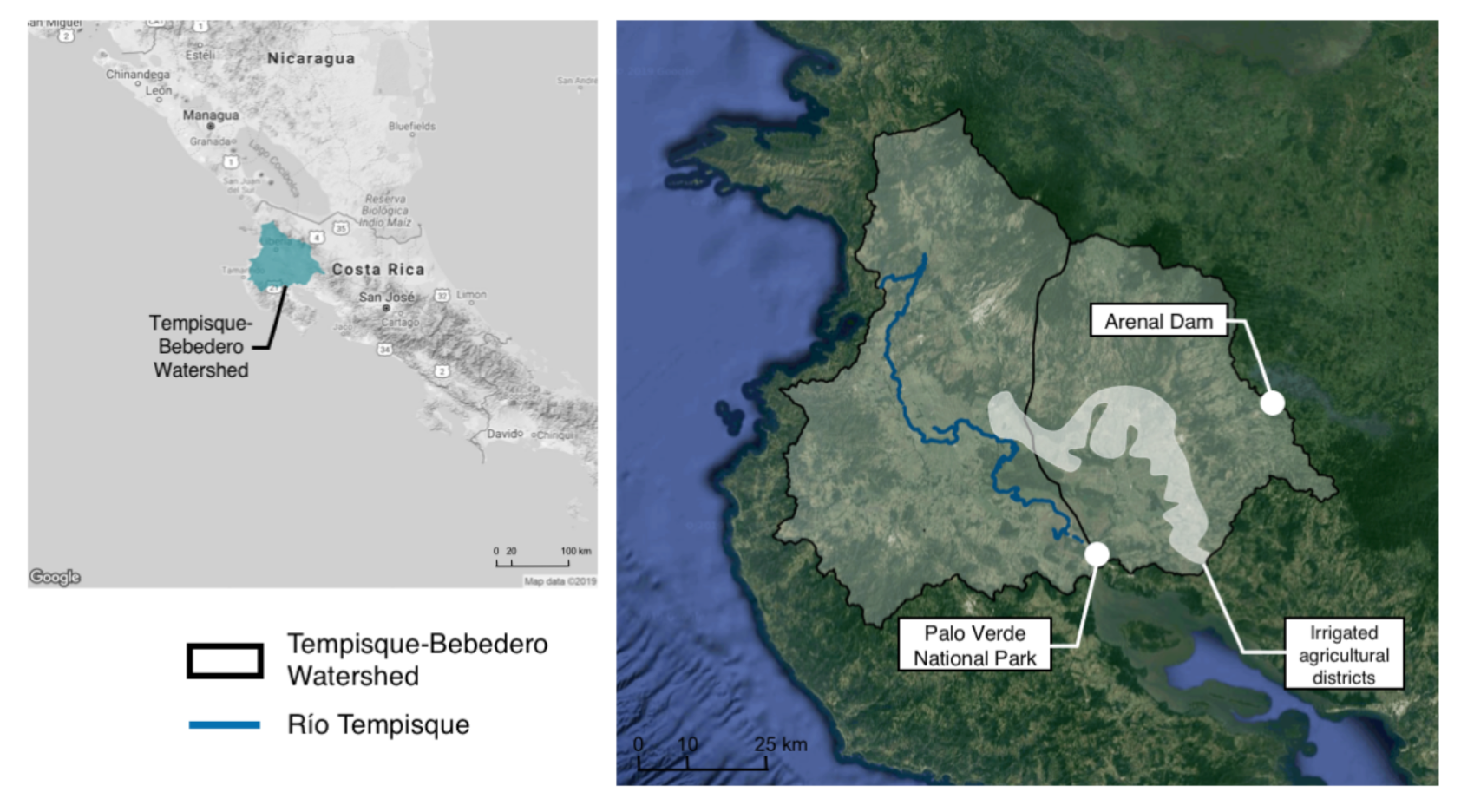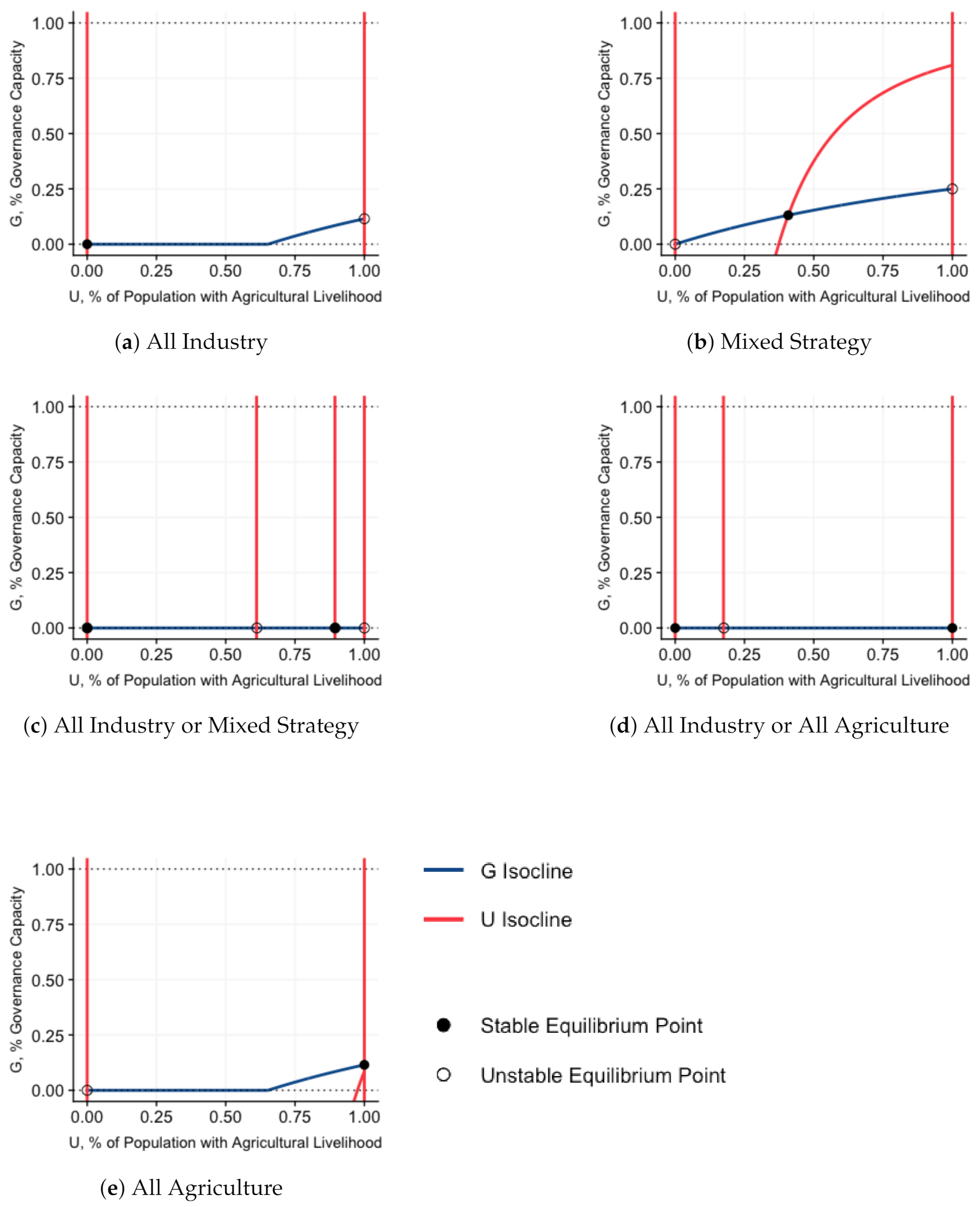Modeling Resilience and Sustainability of Water-Subsidized Systems: An Example from Northwest Costa Rica
Abstract
:1. Introduction
2. Model Description
2.1. Site Description
2.2. Dynamical Variables
2.2.1. Eco-Hydrologic Variables
2.2.2. Social Variables
2.3. Putting Them Together
2.4. Final Model
3. Results and Discussion
4. Conclusions and Final Remarks
Author Contributions
Funding
Institutional Review Board Statement
Informed Consent Statement
Data Availability Statement
Acknowledgments
Conflicts of Interest
Appendix A. Selecting Dynamical Variables

Appendix B. Model Simplification through Time-Scale Separation
Appendix C. Stability analysis
References
- Sinha, P.; Rollason, E.; Bracken, L.J.; Wainwright, J.; Reaney, S.M. A new framework for integrated, holistic, and transparent evaluation of inter-basin water transfer schemes. Sci. Total Environ. 2020. [Google Scholar] [CrossRef] [PubMed]
- Murgatroyd, A.; Hall, J.W. The Resilience of Inter-basin Transfers to Severe Droughts With Changing Spatial Characteristics. Front. Environ. Sci. 2020. [Google Scholar] [CrossRef]
- Langridge, R.; Christian-Smith, J.; Lohse, K.A. Access and resilience: Analyzing the construction of social resilience to the threat of water scarcity. Ecol. Soc. 2006. [Google Scholar] [CrossRef] [Green Version]
- Davies, B.R.; Thoms, M.; Meador, M. An assessment of the ecological impacts of inter-basin water transfers, and their threats to river basin integrity and conservation. Aquat. Conserv. Mar. Freshw. Ecosyst. 1992. [Google Scholar] [CrossRef]
- Bohensky, E.; Reyers, B.; van Jaarsveld, A.S.; Fabricius, C. Ecosystem Services in the Gariep Basin: A Component of the Southern African Millennium Ecosystem Assessment (SAfMA); Technical Report; African Sun Media: Stellenbosch, South Africa, 2004. [Google Scholar]
- Kandasamy, J.; Sounthararajah, D.; Sivabalan, P.; Chanan, A.; Vigneswaran, S.; Sivapalan, M. Socio-hydrologic drivers of the pendulum swing between agricultural development and environmental health: A case study from Murrumbidgee River basin, Australia. Hydrol. Earth Syst. Sci. 2014, 18, 1027–1041. [Google Scholar] [CrossRef] [Green Version]
- Gordon, L.J.; Finlayson, C.M.; Falkenmark, M. Managing water in agriculture for food production and other ecosystem services. Agric. Water Manag. 2010. [Google Scholar] [CrossRef]
- Ren, K.; Huang, S.; Huang, Q.; Wang, H.; Leng, G.; Fang, W.; Li, P. Assessing the reliability, resilience and vulnerability of water supply system under multiple uncertain sources. J. Clean. Prod. 2020. [Google Scholar] [CrossRef]
- Emanuel, R.E.; Buckley, J.J.; Caldwell, P.V.; McNulty, S.G.; Sun, G. Influence of basin characteristics on the effectiveness and downstream reach of interbasin water transfers: Displacing a problem. Environ. Res. Lett. 2015. [Google Scholar] [CrossRef] [Green Version]
- Kefayati, M.; Saghafian, B.; Ahmadi, A.; Babazadeh, H. Empirical evaluation of river basin sustainability affected by inter-basin water transfer using composite indicators. Water Environ. J. 2018. [Google Scholar] [CrossRef]
- Xu, Z.X.; Takeuchi, K.; Ishidaira, H.; Zhang, X.W. Sustainability analysis for Yellow River water resources using the system dynamics approach. Water Resour. Manag. 2002. [Google Scholar] [CrossRef]
- Wilson, M.C.; Li, X.Y.; Ma, Y.J.; Smith, A.T.; Wu, J. A Review of the economic, social, and environmental impacts of China’s South–North Water Transfer Project: A sustainability perspective. Sustainability 2017, 9, 1489. [Google Scholar] [CrossRef] [Green Version]
- Guzmán Arias, I.; Calvo Alvarado, J.C. Water resources of the Upper Tempisque River Watershed, Costa Rica Water resources of the Upper Tempisque River Watershed, Costa Rica (Technical note). Tecnol. Marcha 2012, 25, 63–70. [Google Scholar] [CrossRef] [Green Version]
- Guzmán-Arias, I.; Calvo-Alvarado, J. Planning and development of Costa Rica water resources: Current status and perspectives. Tecnol. Marcha 2013, 26, 52–63. [Google Scholar] [CrossRef]
- Osland, M.J.; Gonzalez, E.; Richardson, C.J. Restoring diversity after cattail expansion: Disturbance, resilience, and seasonality in a tropical dry wetland. Ecol. Appl. 2017, 21, 715–728. [Google Scholar] [CrossRef] [Green Version]
- Alonso, A.; Kennedy, R.E.; Murcia, C. Wetland Landscape Spatio-Temporal Degradation Dynamics Using the New Google Earth Engine Cloud-Based Platform: Opportunities for Non-Specialists in Remote Sensing. Trans. ASABE 2016, 59, 1331–1342. [Google Scholar] [CrossRef] [Green Version]
- Kahle, D.; Wickham, H. ggmap: Spatial visualization with ggplot2. R J. 2013. [Google Scholar] [CrossRef] [Green Version]
- Corbett, J.; Grube, D.C.; Lovell, H.; Scott, R. Singular memory or institutional memories? Toward a dynamic approach. Governance 2018, 31, 555–573. [Google Scholar] [CrossRef] [Green Version]
- Nowak, M.A. Evolutionary Dynamics: Exploring the Equations of Life; Harvard University Press: Chicago, IL, USA, 2006. [Google Scholar]
- Kuzdas, C.; Warner, B.P. Conflict and Cooperation Costa Rica’s Water Sector: Lessons for Water Management. In The Ecolaboratory: Environmental Governance and Economic Development in Costa Rica; University of Arizona Press: Tucson, AZ, USA, 2020; pp. 276–289. [Google Scholar]
- Warner, B.P.; Kuzdas, C.; Yglesias, M.G.; Childers, D.L. Limits to adaptation to interacting global change risks among smallholder rice farmers in Northwest Costa Rica. Glob. Environ. Chang. 2015, 30, 101–112. [Google Scholar] [CrossRef] [Green Version]
- Kaune, A.; Werner, M.; Rodríguez, E.; Karimi, P.; de Fraiture, C. A novel tool to assess available hydrological information and the occurrence of sub-optimal water allocation decisions in large irrigation districts. Agric. Water Manag. 2017, 191, 229–238. [Google Scholar] [CrossRef]
- OECD. Agricultural Policies in Costa Rica; OECD Publishing: Paris, France, 2017. [Google Scholar] [CrossRef]
- Hunt, C.A.; Durham, W.H.; Driscoll, L.; Honey, M. Can ecotourism deliver real economic, social, and environmental benefits? A study of the Osa Peninsula, Costa Rica. J. Sustain. Tour. 2015, 23, 339–357. [Google Scholar] [CrossRef]
- Lansing, D.; Bidegaray, P.; Hansen, D.O.; McSweeney, K. Placing the plantation in smallholder agriculture: Evidence from Costa Rica. Ecol. Eng. 2008. [Google Scholar] [CrossRef]
- Morales, L.; Pratt, L. Analysis of the Daniel Oduber Quirós Airport, Liberia, Guanacaste; Center For Responsible Travel: Washington, DC, USA, 2010. [Google Scholar]
- University of Florida; Organización de Estudios Tropicales; Universidad de Cooperación Internacional. Taller de Creación de Escenarios Futuros Sobre los Recursos Hídricos, el Ambiente, la Agricultura y Los Medios de Vida Bajo el Cambio Climático en la Cuenca Arenal-Tempisque; 2018; unpublished report. [Google Scholar]
- Peterson, G.D.; Cumming, G.S.; Carpenter, S.R. Scenario planning: A tool for conservation in an uncertain world. Conserv. Biol. 2003, 17, 358–366. [Google Scholar] [CrossRef] [Green Version]
- O’Brien, F.A. Scenario planning—Lessons for practice from teaching and learning. Eur. J. Oper. Res. 2004, 152, 709–722. [Google Scholar] [CrossRef]
- Gunawardena, J. Some lessons about models from Michaelis and Menten. Mol. Biol. Cell 2012, 23. [Google Scholar] [CrossRef] [PubMed]




| Symbol | Unit | Definition |
|---|---|---|
| Dynamical Variables | ||
| W | L | Water in Tempisque |
| L | Water in PVW | |
| U | - | % of population participating in the agricultural sector |
| G | - | Governance capacity: the ability to mitigate adverse effects of drought |
| C | - | Cattail coverage as % of the wetland area |
| Parameters | ||
| L/T | Inflows of water, including the portion transferred/imported into the basin | |
| 1/NT | Per capita water allocation rate to farmers | |
| 1/T | Water allocation rate to alternative industry | |
| q | 1/T | Rate of water leaving the Tempisque River and entering Palo Verde Wetland |
| 1/T | Rate of water leaving Palo Verde Wetland | |
| r | N/$ | Population responsiveness to difference in profit |
| n | N | Population size in the system |
| $/NT | Per capita income stream for people in alternative industry | |
| $/NT | Per capita income stream for people in the agricultural sector | |
| p | $/(L) | Factor converting agricultural water allocation to profit |
| b | $/NT | Base per capita agricultural profit |
| c | L/NT | Per capita farmer allocation threshold, below which drought occurs |
| f | L | flood cutoff |
| D | 1/T | Decay rate of governance capacity |
| - | % Damage by birds to agricultural products | |
| m | N/L | Rate of improvement of governance capacity dependent on severity of drought |
| g | 1/T | Natural growth rate of cattail |
| 1/([M/L]T) | Additional cattail growth rate induced by increased nutrient concentration due to agricultural activities | |
| k | M/L | Nutrient concentration in agricultural runoff |
| F | 1/T | Rate of fangueo (mechanical cattail removal) |
| Symbol | Definition | Interpretation |
|---|---|---|
| w | Rescaled water availability in the basin | |
| Rescaled water in Palo Verde Wetland | ||
| Rescaled time | ||
| Relative water allocation rate to agriculture compared to the natural draining rate of the watershed | ||
| Relative water allocation rate to alternative industry compared to the rate at which water leaves the watershed | ||
| Ratio of water exiting to water entering PV | ||
| Rate of people entering alternative industry relative to the rate at which water leaves the watershed | ||
| Rescaled profit factor for agriculture | ||
| Rescaled flood threshold | ||
| Rescaled drought threshold | ||
| Potential rate of people entering the agricultural sector relative to the rate at which water leaves the watershed | ||
| Rescaled maintenance/improvement rate of governance capacity | ||
| Decay rate of governance capacity (due to loss of institutional memory) relative to the rate at which water leaves the watershed | ||
| Natural cattail growth rate relative to the rate at which water leaves the watershed | ||
| Additional cattail growth due to nutrient pollution relative to the rate at which water leaves the wetland | ||
| Fangueo rate relative to the rate at which water leaves the watershed |
Publisher’s Note: MDPI stays neutral with regard to jurisdictional claims in published maps and institutional affiliations. |
© 2021 by the authors. Licensee MDPI, Basel, Switzerland. This article is an open access article distributed under the terms and conditions of the Creative Commons Attribution (CC BY) license (http://creativecommons.org/licenses/by/4.0/).
Share and Cite
Vazquez, K.; Muneepeerakul, R. Modeling Resilience and Sustainability of Water-Subsidized Systems: An Example from Northwest Costa Rica. Sustainability 2021, 13, 2013. https://doi.org/10.3390/su13042013
Vazquez K, Muneepeerakul R. Modeling Resilience and Sustainability of Water-Subsidized Systems: An Example from Northwest Costa Rica. Sustainability. 2021; 13(4):2013. https://doi.org/10.3390/su13042013
Chicago/Turabian StyleVazquez, Kathleen, and Rachata Muneepeerakul. 2021. "Modeling Resilience and Sustainability of Water-Subsidized Systems: An Example from Northwest Costa Rica" Sustainability 13, no. 4: 2013. https://doi.org/10.3390/su13042013






